Like a lot of corn farmers in America’s heartland, Don and Barb Batie in Nebraska are struggling to make ends meet and worry next year may bring another year of limited profitability or even losses.
“The farm crisis in the 1980s was much worse than what we currently have,” says Don Batie, a fourth-generation farmer. “But we’re headed in the same direction.”
The U.S. Department of Agriculture is forecasting that cash receipts for corn and soybean farmers will be down in 2017. Yet it’s a different story for some livestock farmers, especially those who raise hogs. Also, cattle feedlots were under pressure but have recovered in the past year.
“If you look at the general economy and the ag economy, they generally kind of historically have run countercyclical to one another,” says Curt Hudnutt, Rabobank’s St. Louis-based North America’s head of rural banking. “While the U.S. economy felt the recession in 2008, we were having record years in agriculture.”
Hudnutt said some corn farmers in the Midwest have been experiencing “below break-evens.” He continues, saying: “This is really year three now. We really expect more of the same in 2018. It’s not simply a matter of grain prices as it is input costs [such as seed, chemical and fertilizer supplies] are not coming down as quickly as grain prices have fallen.”
Overall, crop cash receipts — the income from crop sales during the 2017 — are forecast to be $189.9 billion, down 2 percent from last year. That would represent the fifth-consecutive year of lower corn receipts, and the total dollar value of the crop is expected to be the lowest number recorded since 2009, according to USDA economist Carrie Litkowski.
Corn represents about 13 percent of total ag commodity receipts in the U.S., ranked second only behind cattle. It is also the main U.S. grain feed, and almost 40 percent of the crop gets used for ethanol.
“A lot of operations are having trouble adjusting to the fact that we had such a tremendous commodity runup from about 2007 to 2013 where there was tremendous margins in the production of corn and soybeans,” says Mark Kenney, a farmer in central Iowa. He said some farmers’ cost structures shifted along with that runup, and now they’re still catching up with lower crop prices.
Analysts say there was a limited time during the year when farmers could have sold corn at profitable levels. Also, some farmers who were fortunate to have large yields on their crops fared better this year by lowering the amount of loss they had.
“It was another poor year from an overall profitability in grain agriculture,” says Don Roose, president of Iowa broker U.S. Commodities. “It was the second year in a row that we had less than ideal growing conditions. But we had yields that outperformed what the producers bought, primarily because of the genetics … and the new technology practices that are going on.”
For corn, average monthly prices have trended below $3.50 per bushel this year and remained below $4 since late mid-2014. That is well below the $7 per bushel price it averaged during some months of 2012-2013.
“Farming is all about cycles, and back in 2013 we really had some super corn, soybean and wheat prices that really afforded us the opportunity to pay down debt, replace some equipment,” says Richard Guebert Jr., president of the Illinois Farm Bureau and a grower of corn, wheat and soybeans.
“Now we’re in a downturn in the farm economy where farmers are not buying particularly new equipment unless they absolutely have to.”
Adding to the challenge is weather in key parts of the Corn Belt has been unfavorable this year, including portions of Nebraska, Iowa and Illinois.
In Nebraska, the Baties lost money on their corn and soybean crops this year, partly reflecting wind storm damage in October that wiped out about 30 percent of one corn field. This will be the third bad year crop-wise for their agribusiness, and the couple isn’t optimistic next year is looking any better.
They live in Lexington, Nebraska, a mostly agriculture-based community of about 11,000 people and draw salaries out of the family farm corporation to cover their living expenses. They cut their salaries in half this year to try to help out, and it still wasn’t enough to cover all the bills. They made the sacrifice to keep a full-time worker on the payroll who otherwise would have been let go.
“We’re starting to see this on a number of farm operations around the state,” says Barb Batie, adding that part-timers and full-time employees are getting cut at other farms in the region. “It’s tough to be optimistic.”
They say the ripple effects of low crop prices and depressed farm incomes are already being felt in the southern Nebraska town and across several industries. For example, the couple said farm machinery dealerships are not selling equipment, car dealerships are having tough times and furniture stores are feeling the impact.
They know of third-generation farmers in the region who are looking for second jobs to help offset losses and pay grocery and utility bills. And, some of those growers are trying to decide whether to get out of farming.
“There’s a point when it’s time to quit,” says Don Batie.
Even so, it’s tougher to sell farmland today in some parts of the heartland. Prices of ag land in areas of the Midwest have fallen 20 to 25 percent from the peak.
“We’ve had more no-sales recently than we’ve had sales complete and close,” says Shan Hanes, president and CEO of Heartland Tri-State Bank in Elkhart, Kansas. He said some people who saw the farmland runup several years ago are trying to sell but finding the market just isn’t giving them much today — and he’s not hopeful things will change in 2018 and 2019.
The Federal Reserve Bank of Kansas City’s Ag Credit update last month reported that irrigated farmland values are down 5 to 7 percent from a year ago in some Midwest states, including Kansas and Nebraska. Lower farmland prices ultimately make it tougher for farmers to obtain credit.
“Although the magnitudes of recent declines have yet to approach the magnitudes of the 1980s, the duration of the recent downturn in cropland values has approached that of the 1980s,” the Ag Credit Survey says.
During the 1980s farm downturn, farmers were debt-heavy and faced high interest rates. Today, the debt levels are substantially lower for farmers and interest rates are more favorable.
Regardless, some in agribusiness still worry about another year of low crop prices and the added uncertainty surrounding the North American Free Trade Agreement between the U.S., Canada and Mexico. President Donald Trump, who carried many ag-important heartland states in the 2016 election, has threatened to tear up the 24-year-old NAFTA deal.
“We have concern if NAFTA is disrupted,” says Rabobank’s Hudnutt. “Exports are extremely important to the U.S. farmer.”
Mexico and Canada represent nearly one-third of total U.S. agricultural exports. Corn, soybeans, fresh fruits and vegetables as well as livestock and dairy are major U.S. exports to those countries.
Hudnutt believes “internal pressures as well as external pressures from farm groups and others are getting to the president and talking about the importance of NAFTA to agriculture.”
Source: MSN












